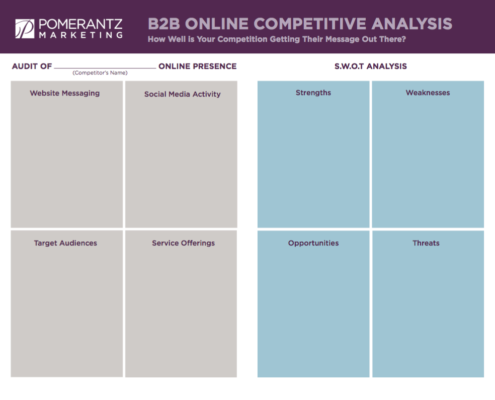B2B Online Competitive Analysis
JUMPSTART STEP 4: B2B ONLINE COMPETITIVE ANALYSIS
How Well is Your Competition Getting Their Message Out There?
When you’re trying to get your own marketing in order, performing an audit of your competitors’ online presence can be really helpful. Especially if you’re still trying to fine tune your own voice and place in the market, knowing what others are doing and saying is key. So let’s talk about what goes into a B2B online competitive analysis and outline the important areas to cover.
The first step in performing a competitor audit is to identify your major competitors. You want to choose enough to get a broad view of your market, but not too many that the task will overwhelm you. We’ve found 5-7 to be the sweet spot. Make sure to pick a few companies that you actually compete with who are similar in size and geography to you. It’s also helpful to include a few “reach” competitors – the leaders of your industry or those performing at the top of the game.
Once you have your list (it’s a good idea to get input on that list from multiple people, by the way, so reach out to your business leaders, sales and even operations for their ideas), it’s time to start auditing! I know, that sounds kind of boring. But it really can be fun and absolutely will be helpful to developing your own marketing plan.
Where to begin? Here are the main areas to include in your review and analysis of your competitors plus a template to help you organize your thoughts.
1. Communication and Messaging Strategy
In order to ensure your own messaging is authentic and relevant, you need to know what others are saying. The best way to get a good grasp on your competitors’ communication strategy is to dig into their websites. Read their home pages especially closely, and note what they’re emphasizing there.
After that, click through their site menus. Note what gets the most real estate and what doesn’t. If they have callouts, headers or other areas that are highlighted, pay attention to what they’re saying and how they say it. Take note of any customer promises and claims. Are they really speaking to their audience and their pain points, or are they only talking about how great they are? Put on your critic’s hat and really think about what they’re trying to say and if it’s successful.
Also spend some time checking out their social media profiles. What is the intensity of their activity in each channel? Does the messaging and tone of voice align with what’s on their website? Are there areas they’re missing or things they’re doing particularly well? By focusing on the specifics here, you may find new opportunities for your own business to stand out.
2. Target Audiences and Segments
When you’re reading through the site, see if it’s easy to identify who they’re targeting. Are there industries or verticals that they call out specifically? Do they appear to have especially good credibility or business with one segment more than others?
If you’ve already spent some time honing your target audiences and personas, you have some good background knowledge in this area. Figure out if your competitors are doing the same thing by reading their content closely and looking for signs of who they may be targeting.
3. Service Offerings
While you and your sales team probably already know a fair amount about your competitors’ service offerings, it’s always interesting to see how they portray themselves. We’ve often found that companies portray their expertise differently from reality. List the service offerings they give the most importance on their site and review them with the sales team – does it align with what they know about the competitor? If so, it’s good to know the basics of what they do; if not, those may be areas they’re hoping to expand.
Note their strengths, weaknesses and unique offerings. Do you think they’re doing everything well or spreading themselves too thin?
4. Areas for Differentiation
Identify areas for differentiation as you’re analyzing their online presence. Write up some notes on overall takeaways or generalities that have come through during your audit. Use all of this information to perform a SWOT analysis. Mapping all of the strengths, weaknesses, opportunities and threats for each competitor will really highlight differentiation opportunities.
When you look at all of the competitor audits together, you should find some gaps that leave openings for your business to shine! What are they doing that you want to do in your own (better) way? What are they not doing that leaves space for differentiation? From there, it will be much easier to develop your own messaging and online presence that is unique, true to your business and tailored to your own strengths and audiences.




